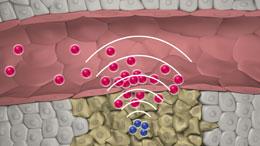摘要:美国研究人员最新开发出一种纳米粒子,外观呈棒状,可以随血液流动“侦察”到肿瘤部位,帮助药物到达病灶处,从而有效消灭肿瘤。

“侦察”肿瘤的纳米粒子
Bhatia团队的灵感来自于人体的凝血系统,机体一旦受伤,在受伤部位凝血系统会有一系列相应的反应,由于这样的一个级联反应,导致了大量纤维蛋白的交联,最终血液凝块得以形成。
研究人员设计的纳米粒子搭载到此级联系统上。Bhatia说:“我们用机体与生俱来的生物放大过程来获得更多的靶向药物。”这项研究发表于Nature Materials。
肿瘤部位的血管通常会有病态变大的孔洞,纳米粒子进入这些孔洞中会刺激周边组织,使机体发出一种类似有伤口要求凝血物质聚集的信号。此时,另外一种携带药物的“攻击型”纳米粒子就会循信号而来,帮助消灭肿瘤。
美国剑桥麻省理工学院生物工程专家Sangeeta Bhatia和她的同事发现,在小鼠中先后用两种不同类型的纳米粒子,可以使传递到肿瘤的药物量增加40倍,这些小鼠体内的肿瘤停止了生长,而在那些只接收了一种类型纳米粒子的小鼠并没有产生这种现象。
不过研究人员也表示,在这项成果应用于人类临床前,还需要解决的一个问题是如何确保“侦察兵”发出的信号不为其他生理活动所干扰,因为癌症病人身体的其他一些部位有时也会发出凝血信号,这时就要想办法保证药物不伤及正常的机体组织。
生物探索推荐:
Nature:肿瘤细胞周期调控的一种关键因子——CUEDC2
生物探索推荐英文原文:
Nanoparticles hit tumours with one-two punch
By harnessing the body's blood-clotting system, researchers have designed nanoparticles that scout out tumours and then call in a second type of nanoparticle to deliver cancer-killing drugs.
Sangeeta Bhatia, a bioengineer at the Massachusetts Institute of Technology in Cambridge, and her colleagues found that using the two nanoparticles in tandem in mice increased the amount of drug delivered to a tumour by 40-fold relative to controls. Tumours in these mice stopped growing, whereas those in mice that received only one type of nanoparticle did not.
Bhatia's team was inspired by the ability of the body's clotting system to mount a huge response at an injured site. A clot forms thanks to a cascade of reactions that leads to the cross-linking of a large amount of a protein called fibrin.
The researchers designed their nanoparticles to piggyback on this cascade. "We use the body's natural amplification processes to get more drug to the target," says Bhatia. The study is published in Nature Materials.
Division of labour
Several targeted, drug-delivering nanoparticles are already in use, and more are in clinical trials. Some of these particles have molecules on their surface that bind to receptors on the target tissue.
Bhatia's team decided to allocate each job — finding the tumour and delivering the drug — to a different particle.
The 'scout' nanoparticle, a gold nanorod, is designed to fit through the abnormally large pores of the tumour's blood vessels. When near-infrared light is shone on the nanorods, they heat up just enough to damage the tumour and trigger the clotting cascade.
At the end of the cascade, an enzyme called Factor XIII cross-links fibrin to grow the clot. The drug-bearing nanoparticle, called the receiver, has a protein fragment on its surface that is a substrate for Factor XIII. The particles are attracted as the clotting process occurs at the tumour.
Factor XIII then cross-links the receivers' protein coating to the fibrin in the clot, where the receivers unload their drug cargo. The Factor XIII and fibrin generated during the clotting process produce additional binding sites at the tumour for the receiver nanoparticle, which leads to the 40-fold increase in the amount of drug delivered.
This is a big improvement on other nanoparticles, which typically deliver 2–7 times the dose of conventional drug delivery methods, says Omid Farokhzad at the Brigham and Women's Hospital in Boston, Massachusetts. "What's new here is that the system triggers the body to create an environment that favours the accumulation of nanoparticles," he says.
Clotting complexity
"This is on the right path," says Farokhzad. "But given the level of innovation, a lot of work will be needed to translate this to the clinic."
One challenge will be to ensure that the particles trigger and target blood clots only in tumours, as cancer patients are susceptible to blood clots elsewhere in the body, says Anil Sood, an oncologist at the MD Anderson Cancer Center in Houston, Texas. "If you're going to trigger coagulation, you want to be very selective, so that you don't cause damage in other parts of the body."
Bhatia admits that her system is complex; her group is working on ways to simplify it. But cancer is a complex disease, says Dan Peer, a nanotechnologist at Tel Aviv University in Israel. "Maybe the solutions won't be so simple."







